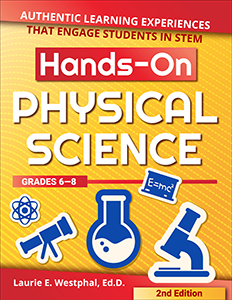Hands-On Physical Science in Middle School
Hands-On Physical Science, Grades 6-8: Authentic Learning Experiences That Engage Students in STEM
By Laurie E. Westphal, Ed.D.
(Prufrock Press, 2019 – Learn more)

We live in a time where students are tempted to find answers to questions they have by simply “Googling them” without being challenged to think for themselves.
Hands-On Physical Science, Grades 6-8: Authentic Learning Experiences That Engage Students in STEM does not allow students this luxury, and challenges them to develop ways to solve tasks and answer questions while using an inquiry-based approach.

Each activity includes an objective, rationale, list of materials, activity preparation and activity procedure. Where applicable, evaluation sheets, recording sheets, lab station cards that contain directions, and rubrics are included and can be photocopied with ease.
Linking exercises to real life
This book allows plenty of room for guidance and direct instruction where needed. My favorite aspect is that each chapter begins with a student design or research project that provides students an initial experience on which to connect new learning.
Students are challenged to connect what they’ve learned to real life examples within the post lab questions. There are also opportunities for students to research, present and provide peer feedback in a couple chapters. The activities could be modified to fit any preferred format for a science lab notebook.
Resources for new science teachers
Teachers who do not have a strong science background may need to spend some time brushing up on vocabulary, mathematical formulas and scientific processes that are presented as part of this book. The extra resources provided would help alleviate this. A few of the activities require a junk box of materials, which students could contribute to, but that teachers would need to start in advance.
At certain points in the book I felt as though the author presumed that students would have quite a bit of prior knowledge about physical science processes. However, she explains that this approach is intentional and allows for students to question and observe things that weren’t originally intended. Younger students may need to be front-loaded with some vocabulary (which is included) and visual examples of processes, even prior to the design projects.
Reasons to read Hands-On Physical Science
In my opinion any middle grades physical science teacher would benefit from the engaging, hands-on opportunities presented in this book. The author takes abstract physical science concepts and makes them more concrete by allowing students to experience hands-on examples. There is a nice balance between standard “cookbook” directions and students guiding their own inquiry based experience. Individual, small group and large group experiences are all included.
This book also provides alignment with the Next Generation Science Standards (NGSS) in each chapter and lends itself to providing students cross-curricular connections in the disciplines of math, engineering, language arts, history and technology.
Tracy Albers has completed her 18th year in education teaching at the middle school level. She currently teaches sixth and eighth grade science in Brookfield, Wisconsin. Tracy serves on various committees within her school, as well as acting as a team leader. It is her belief that students need to experience practical, hands-on experiences that make sense of the world around them.



































Now all we need is a companion edition for high school! Opposable thumbs-up Ms Westphal.